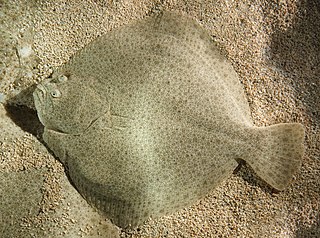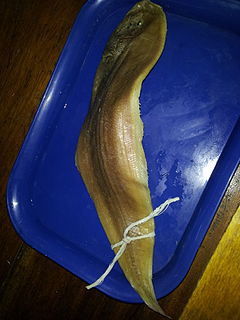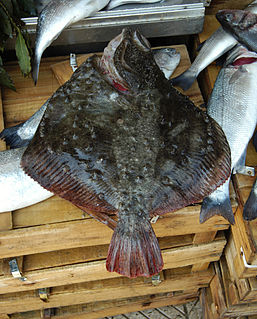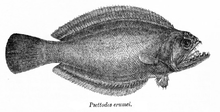
Cod is the common name for the demersal fish genus Gadus, belonging to the family Gadidae. Cod is also used as part of the common name for a number of other fish species, and one species that belongs to genus Gadus is commonly not called cod.

Mackerel is a common name applied to a number of different species of pelagic fish, mostly from the family Scombridae. They are found in both temperate and tropical seas, mostly living along the coast or offshore in the oceanic environment.

The true soles are a family, Soleidae, of flatfishes. It includes saltwater and brackish water species in the East Atlantic, Indian Ocean, and West and Central Pacific Ocean. Freshwater species are found in Africa, southern Asia, New Guinea, and Australia.

The turbot is a relatively large species of flatfish in the family Scophthalmidae. It is a demersal fish native to marine or brackish waters of the Northeast Atlantic, Baltic Sea and the Mediterranean Sea. It is an important food fish. Turbot in the Black Sea have often been included in this species, but are now generally regarded as separate, the Black Sea turbot or kalkan. True turbot are not found in the Northwest Atlantic; the "turbot" of that region, which was involved in the so-called "Turbot War" between Canada and Spain, is the Greenland halibut or Greenland turbot.

Citharichthys is a genus of flatfish in the large-tooth flounder family, Paralichthyidae. They have both eyes on the left sides of their heads. They are native to the oceans around the Americas, with a single species, C. stampflii off the West African coast. Most are found in relatively shallow depths, but the genus also includes species found in deep water and species that enter fresh water.

The Scophthalmidae are a family of flatfish found in the North Atlantic Ocean, Baltic Sea, Mediterranean Sea, and Black Sea. Fish of this family are known commonly as turbots, though this name can refer specifically to Scophthalmus maximus, as well.

Demersal fish, also known as groundfish, live and feed on or near the bottom of seas or lakes. They occupy the sea floors and lake beds, which usually consist of mud, sand, gravel or rocks. In coastal waters they are found on or near the continental shelf, and in deep waters they are found on or near the continental slope or along the continental rise. They are not generally found in the deepest waters, such as abyssal depths or on the abyssal plain, but they can be found around seamounts and islands. The word demersal comes from the Latin demergere, which means to sink.

Echinorhinus is the only extant genus in the family Echinorhinidae.

The brill is a species of flatfish in the turbot family (Scophthalmidae) of the order Pleuronectiformes. Brill can be found in the northeast Atlantic, Black Sea, Baltic Sea, and Mediterranean, primarily in deeper offshore waters.

Tonguefishes are flatfish in the family Cynoglossidae. They are distinguished by the presence of a long hook on the snout overhanging the mouth, and the absence of pectoral fins. Their eyes are both on the left side of their bodies, which also lack a pelvic fin. This family has three genera with a total of more than 140 species. The largest reaches a length of 66 cm (26 in), though most species only reach half that size or less. They are found in tropical and subtropical oceans, mainly in shallow waters and estuaries, though some species are found in deep sea floors, and even a few in rivers.

Berycidae is a small family of deep-sea fishes, related to the squirrelfishes. The family includes the alfonsinos and the nannygais.

The Samaridae are a family, the crested flounders, of small flatfishes native to the Indo-Pacific. They were formerly classified as a subfamily of Pleuronectidae. The family contains four genera with a total of almost 30 species.

Pleuronichthys is a genus of fish in the family Pleuronectidae found in the Pacific Ocean.

Fish are very diverse animals and can be categorised in many ways. This article is an overview of some of ways in which fish are categorised. Although most fish species have probably been discovered and described, about 250 new ones are still discovered every year. According to FishBase, 34,300 species of fish had been described as of September 2020. That is more than the combined total of all other vertebrate species: mammals, amphibians, reptiles and birds.

Harpagifer is a genus of perciform fish, the spiny plunderfishes, native to the southern oceans. It is currently the only genus in its family.

Scophthalmus is a genus of turbots, relatively large flatfish native to the northeast Atlantic Ocean, Baltic Sea, Mediterranean Sea and Black Sea. Flounder has to eyes they swim to the side of the sea ocean after they a few day they eye right eye moves to the top then they can swim in the middle of the sea ocean

The spotted turbot is a flatfish of the family Pleuronectidae. It is a demersal fish that lives on bottoms at depths of between 1 and 50 metres. Its native habitat is the subtropical waters of the Eastern Pacific, from Morro Bay in California to southern Baja California in Mexico. It can grow up to 30 centimetres (12 in) in length.
Citharichthys amblybregmatus is a species of flatfish in the large-tooth flounder family Paralichthyidae. It is native to the western north Atlantic Ocean. It has been collected at a depth of 198 m (650 ft).

Lepidorhombus is a genus of turbots native to the northeastern Atlantic Ocean.

Zeugopterus regius, Eckström's topknot or Bloch's topknot, is a small, left eyed flatfish in the turbot family Scophthalmidae found in European waters.
























